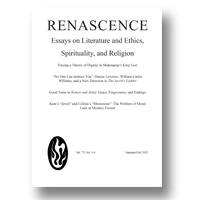|
1.
|
Renascence:
Volume >
75 >
Issue: 3/4
Madeline Read
Tracing a Theory of Human Dignity in Shakespeare’s King Lear
abstract |
view |
rights & permissions
| cited by
Shakespeare’s King Lear prefigures the shape of “dignity” as first imagined by Immanuel Kant, who would argue in 1785 that rational beings are ends in themselves, “something that may not be used merely as means” (46). I do not suggest that Shakespeare secretly used the word “dignity” as it is used today, or even that he himself was any kind of proto-Kantian. Scholars such as Robin Headlam Wells have made the case that his plays are deeply rooted in a Renaissance culture of humanism, which would of course give rise to the discourse of social contracts and universal rights that infused Enlightenment thought—but this does not mean that he was already imagining the kind of rights-bearing human subject that would take shape in the philosophies of Kant, Locke, and Rousseau in the eighteenth century. I do suggest, however, that moments in King Lear hint at an economy in which human value is divorced from wealth, position, or performance: even as Lear sinks lower into disenfranchisement and incapacity, the play insists that his worth does not diminish. If King Lear makes the case for dignity as a quotient of human worth that falls out of the hierarchies of value that first produce and measure worth, the economy it envisions hinges on individuals who can suspend those hierarchies and operate within a space where others command respect simply by being. This economy becomes an aneconomy as it demands respect and dignity in a way traditional exchange economies fail to do; it both asks and enables its participants to be gracious, to let go of the transactional logic by which Lear would have everyone live. Though the image of this world in King Lear is fractured, glimpsed between scenes of great cruelty, malice, and misery, it is nonetheless the climax of Shakespeare’s moral vision for his characters. The narrative enables its viewers to contemplate, if only in fragments, the possibility of absolute human worth.
|
|
|
2.
|
Renascence:
Volume >
75 >
Issue: 3/4
Paul R. Cappucci
“No One Can Instruct You”:
Denise Levertov, William Carlos Williams, and A New Direction in The Jacob’s Ladder
abstract |
view |
rights & permissions
| cited by
This essay examines a critical moment in the poetic relationship of Denise Levertov and William Carlos Williams—the publishing of The Jacob’s Ladder (1961). It considers the scope of Williams’s influence on Levertov, as well as the ways that this collection signals a new spiritual and imaginative direction in her verse. After detailing the development of their friendship, the essay chronicles how the title poem of The Jacob’s Ladder challenged Williams’s understanding of Levertov’s poetics. It also considers the ways that Levertov’s response to Williams’s criticism marked a pivotal moment in her poetic development. Instead of pulling them apart, their exchanges about the poem deepened their appreciation for each other. In this way, the publication of The Jacob’s Ladder reveals Levertov’s connectedness to Williams, as well as her determination to chart a new direction in her work.
|
|
|
3.
|
Renascence:
Volume >
75 >
Issue: 3/4
Patricia Patrick
Good Turns in Romeo and Juliet:
Grace, Forgiveness, and Endings
abstract |
view |
rights & permissions
| cited by
The plot of Romeo and Juliet is shaped by the turns of exchanges. Retributive returns fuel cycles of vengeance that lead to the tragic ending. The prologue notoriously gives this ending away, portraying the tragedy as inevitable, even suggesting that the deaths of Romeo and Juliet were the necessary price of peace. In contrast to these tragic returns, the play also portrays benevolent and liberating kinds of turning. Drawing on civic and religious notions of gracious exchange found in Seneca’s On Benefits and in the Homilies, Shakespeare creates a counterpoint to tragic retribution. These gracious returns offer the liberating possibility of turning aside from a tragic trajectory that is only apparently inevitable.
|
|
|
4.
|
Renascence:
Volume >
75 >
Issue: 3/4
Brett Beasley
Kant’s “Jewel” and Collins’s “Moonstone”:
The Problem of Moral Luck in Mystery Fiction
abstract |
view |
rights & permissions
| cited by
Mystery fiction is sometimes assumed—both by scholars and by general readers—to have a simple or even simplistic relationship to morality. Mysteries, on this view, are straightforward "whodunnits": They satisfy readers by identifying wrongdoing and then assigning blame to the individual or individuals responsible. In this paper, I offer a contrary view. I show that the moral laboratory of mystery fiction often winds up subverting, undermining, and unsettling some of our most basic moral assumptions and our standard approaches to thinking about moral responsibility and moral justification. It does so, I argue, by emphasizing what philosophers term moral luck. I center my analysis on moral luck as it appears in The Moonstone, the novel T. S. Eliot called “the first, the longest, and the best” piece of detective fiction, and I offer suggestions for reading later works of mystery fiction with moral luck in mind.
|
|

